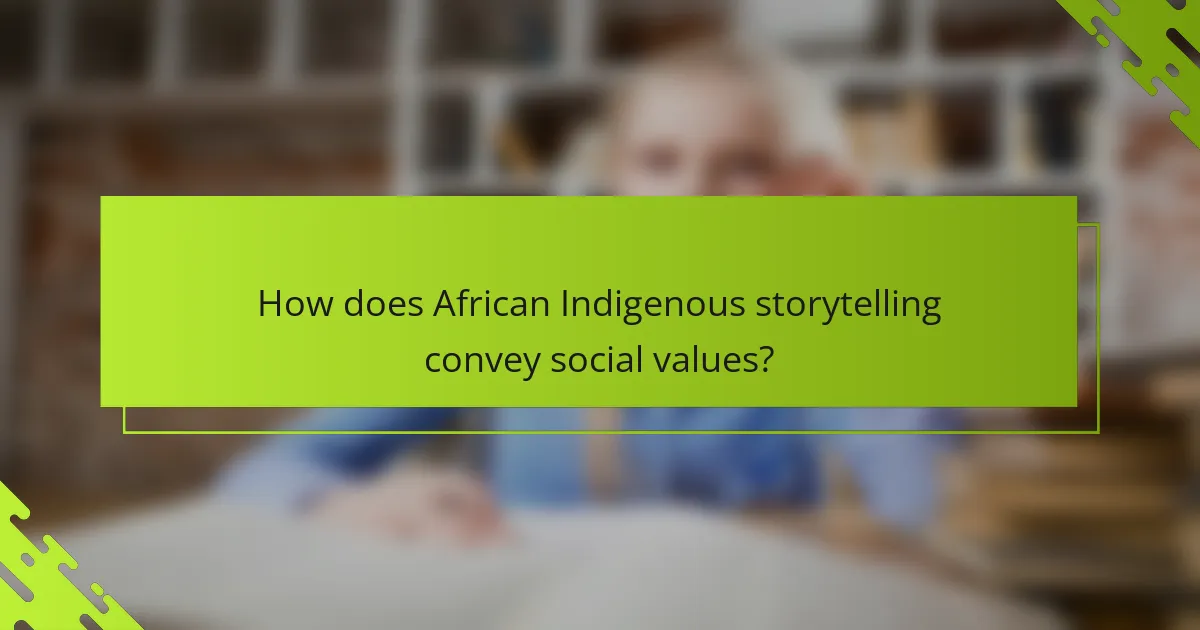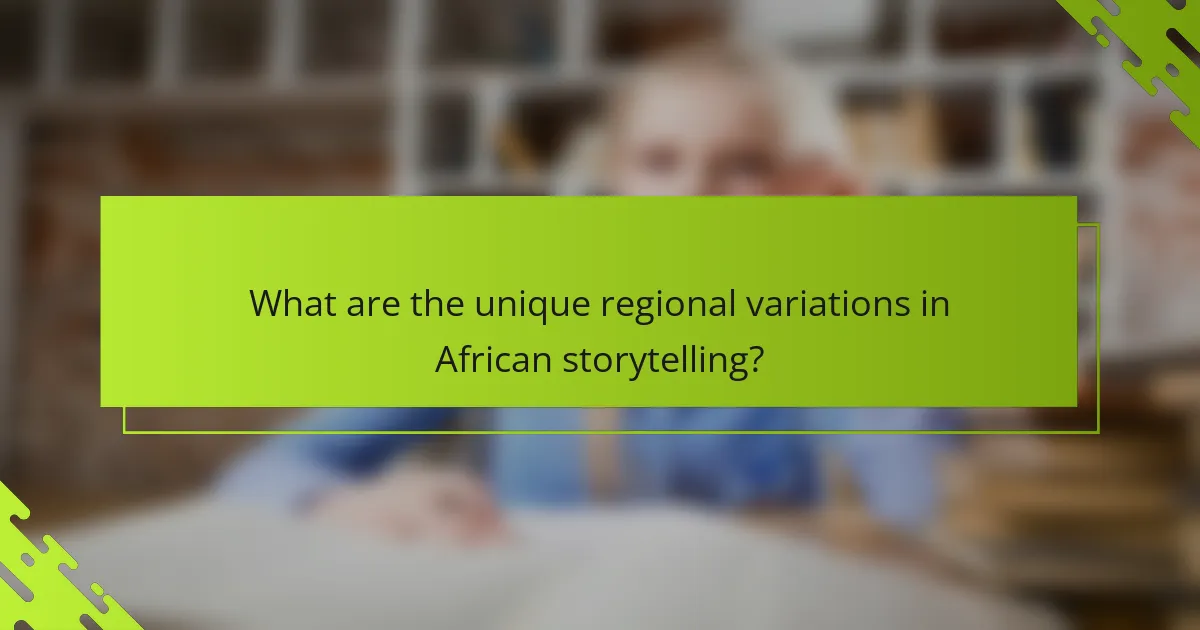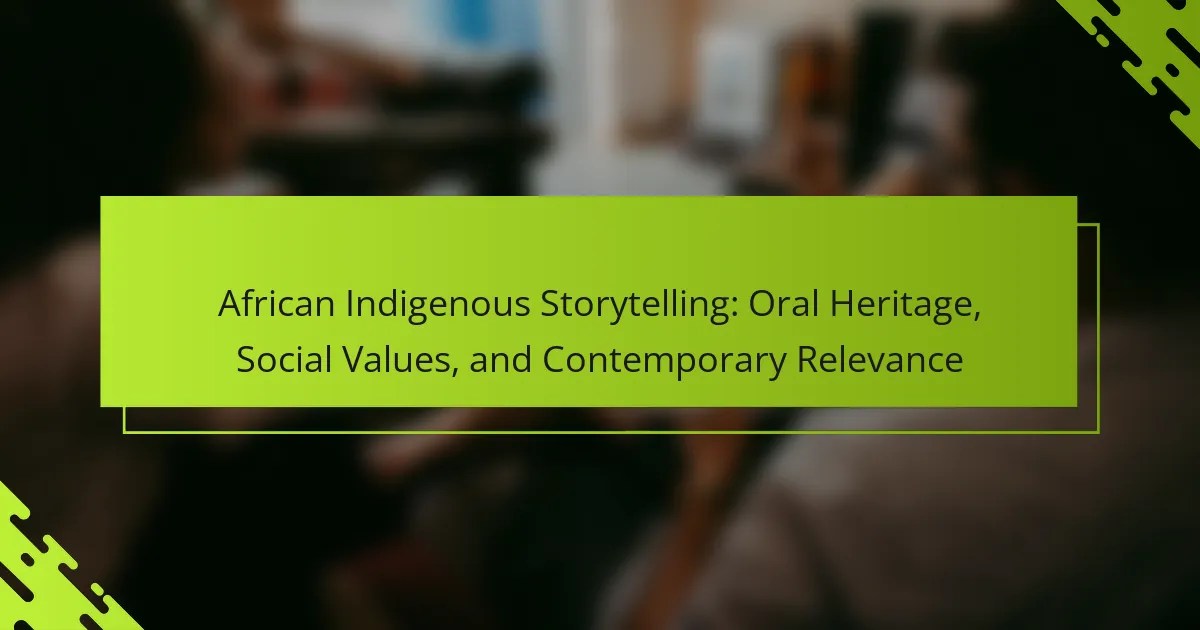African Indigenous storytelling plays a crucial role in preserving cultural heritage and imparting social values. It emphasizes oral transmission, symbolism, and community engagement. Contemporary artists reinterpret these narratives to address modern issues. Regional variations showcase the rich diversity of African oral traditions while highlighting the challenges posed by globalization and technology.

What are the fundamental principles of African Indigenous storytelling?
African Indigenous storytelling emphasizes community, tradition, and moral teachings. It serves as a means to transmit cultural values and history across generations. Key principles include oral transmission, symbolism, and the engagement of audiences through interactive narratives. These stories often reflect communal experiences and address social issues, reinforcing social cohesion. Additionally, contemporary relevance is highlighted as these narratives adapt to modern contexts, ensuring their survival and continued significance.
How do oral traditions shape cultural identity?
Oral traditions significantly shape cultural identity by preserving values, beliefs, and history. African Indigenous storytelling serves as a vital mechanism for community cohesion and identity formation. These narratives transmit social values and moral lessons, reinforcing communal bonds and shared heritage. They also adapt to contemporary contexts, ensuring relevance for younger generations. This dynamic process illustrates how storytelling remains a living tradition, reflecting the evolving identity of African communities. The unique attribute of oral traditions lies in their ability to foster intergenerational dialogue, enriching cultural continuity.
Why is storytelling considered a communal activity?
Storytelling is considered a communal activity because it fosters social bonds and cultural identity. African Indigenous storytelling emphasizes shared experiences and collective values, often performed in group settings. This oral tradition creates a sense of belonging and reinforces social norms. As a result, storytelling serves as a vital tool for preserving cultural heritage and promoting community cohesion.

How does African Indigenous storytelling convey social values?
African Indigenous storytelling conveys social values through narratives that embody cultural norms, ethics, and communal wisdom. These stories often reflect core values such as respect, unity, and resilience, shaping societal behavior and identity. Oral traditions serve as a means to transmit knowledge across generations, ensuring that essential social principles remain relevant. The use of metaphors and allegories in storytelling reinforces moral lessons, making them accessible and memorable for all ages. Through this dynamic, storytelling fosters a sense of belonging and continuity within communities, highlighting its enduring significance in contemporary society.
Which moral lessons are commonly shared through stories?
African Indigenous storytelling imparts moral lessons that emphasize community values, respect for nature, and personal integrity. These narratives often illustrate the consequences of actions, reinforcing the importance of honesty, kindness, and responsibility. For example, tales of tricksters highlight the pitfalls of deceit while promoting wisdom and humility. Additionally, stories often convey respect for elders and the significance of cultural heritage, fostering a sense of identity and belonging within the community. These lessons remain relevant today, guiding moral development in contemporary society.
What role does storytelling play in conflict resolution?
Storytelling plays a crucial role in conflict resolution by fostering understanding and empathy among conflicting parties. African Indigenous storytelling serves as a tool for conveying social values and cultural heritage, facilitating dialogue and reconciliation. It emphasizes shared experiences and collective wisdom, helping individuals see different perspectives and find common ground. This oral tradition remains relevant today, as it promotes peace-building and community cohesion through narratives that resonate with contemporary issues.

In what ways do contemporary artists reinterpret traditional storytelling?
Contemporary artists reinterpret traditional African Indigenous storytelling by infusing modern themes and mediums. They often blend visual arts, performance, and digital platforms to engage new audiences. This approach preserves cultural narratives while addressing contemporary social issues like identity and community resilience. By using innovative techniques, artists maintain the relevance of oral heritage, ensuring its transmission to future generations.
How are modern technologies influencing storytelling methods?
Modern technologies are reshaping African Indigenous storytelling by enhancing accessibility and engagement. Digital platforms allow broader audiences to experience oral traditions, preserving cultural narratives. For instance, social media enables real-time storytelling, fostering community interactions. Additionally, multimedia tools enrich narratives through visuals and sound, making them more impactful. This evolution maintains relevance while honoring social values inherent in traditional storytelling.
Which contemporary themes resonate with traditional narratives?
Contemporary themes such as identity, resilience, and community strongly resonate with traditional narratives in African Indigenous storytelling. These themes reflect social values and address modern challenges while preserving cultural heritage. For instance, storytelling emphasizes the importance of communal bonds, which remains relevant in today’s fragmented societies. Additionally, the theme of resilience is evident in narratives that highlight overcoming adversity, mirroring contemporary struggles faced by many communities. Thus, African Indigenous storytelling continues to serve as a vital link between past and present, fostering understanding and connection.

What are the unique regional variations in African storytelling?
African storytelling exhibits unique regional variations influenced by cultural, linguistic, and historical contexts. For instance, West African storytellers often use proverbs and call-and-response techniques, while East African narratives may emphasize community and oral history preservation. In Southern Africa, storytelling can incorporate music and dance, enhancing the performance aspect. Each region’s stories reflect social values, moral lessons, and communal identity, showcasing the rich diversity of African oral heritage.
How do different cultures express their storytelling traditions?
African Indigenous storytelling expresses cultural values, community bonds, and historical narratives through oral traditions. These stories often convey moral lessons, preserve history, and reinforce social norms. For instance, the Griot tradition in West Africa showcases skilled storytellers who use music and poetry to narrate tales of ancestry and community achievements.
Moreover, storytelling remains relevant today, adapting to contemporary issues while retaining its core values. Many African communities now incorporate modern media, such as radio and digital platforms, to share these rich narratives, ensuring they reach wider audiences. This evolution highlights the resilience of African storytelling as it bridges generations and cultures.
The unique attribute of African storytelling lies in its emphasis on communal participation, where listeners actively engage with the narrative. This interactive aspect fosters a sense of belonging and collective identity, making storytelling a vital social practice.
Overall, African Indigenous storytelling serves as a dynamic vehicle for cultural expression, adapting to modern contexts while preserving deep-rooted traditions.
What are some notable storytellers and their contributions?
Notable storytellers in African Indigenous storytelling include Chinua Achebe, Ngũgĩ wa Thiong’o, and Ayi Kwei Armah. Their contributions highlight oral heritage, social values, and contemporary relevance.
Chinua Achebe’s work emphasizes the importance of cultural identity and the impact of colonialism. His novel “Things Fall Apart” explores traditional Igbo society and its values. Ngũgĩ wa Thiong’o advocates for the preservation of indigenous languages and storytelling forms, promoting social justice through his writings. Ayi Kwei Armah focuses on the complexities of post-colonial African identity, illustrating the struggle to maintain cultural heritage in a changing world.
These storytellers demonstrate the ongoing significance of oral traditions in shaping social narratives and cultural identity in contemporary Africa.

How does African Indigenous storytelling promote intergenerational dialogue?
African Indigenous storytelling fosters intergenerational dialogue by preserving cultural heritage and imparting social values. This oral tradition connects younger generations with their ancestors, facilitating the exchange of wisdom and life lessons. Storytelling serves as a medium for discussing contemporary issues, bridging the gap between past and present. It encourages empathy, respect, and understanding among different age groups, reinforcing community bonds. Through shared narratives, individuals cultivate a sense of identity and belonging, ensuring that cultural knowledge is transmitted effectively.
What techniques are used to engage younger audiences?
Engaging younger audiences through African Indigenous storytelling involves interactive techniques and modern adaptations. Immersive storytelling experiences, such as community workshops, encourage participation and foster connection. Digital platforms, like social media, amplify reach and relevance, allowing for sharing of stories in creative formats. Integrating contemporary themes with traditional narratives resonates with youth values, making the content relatable and impactful. Utilizing visual and auditory elements enhances engagement, appealing to diverse learning styles.
Why is it important to preserve oral heritage for future generations?
Preserving oral heritage is crucial for maintaining cultural identity and social values. African Indigenous storytelling conveys wisdom, history, and community bonds, fostering a sense of belonging. This heritage imparts moral lessons and promotes resilience among future generations. Additionally, it enriches contemporary society by offering diverse perspectives and fostering intercultural dialogue.

What challenges do African Indigenous storytelling traditions face today?
African Indigenous storytelling faces significant challenges today, including globalization, cultural erosion, and technological shifts. These factors threaten the transmission of oral traditions and social values. Globalization often leads to the dominance of Western narratives, overshadowing local stories. Cultural erosion occurs as younger generations become disconnected from their heritage. Additionally, technology, while offering new platforms, can dilute the authenticity of traditional storytelling practices. These challenges impact the preservation of unique attributes within African storytelling traditions, risking the loss of diverse cultural identities.
How do globalization and modernization impact these traditions?
Globalization and modernization significantly challenge African indigenous storytelling, affecting its transmission and relevance. Increased access to global media promotes homogenized narratives, overshadowing traditional tales. As a result, younger generations may prioritize modern forms of entertainment, risking the loss of cultural heritage. However, some communities adapt by blending traditional storytelling with contemporary themes, ensuring continued engagement and relevance. This fusion highlights storytelling’s resilience, demonstrating its ability to evolve while preserving core social values.
What efforts are being made to revitalize storytelling practices?
Efforts to revitalize African Indigenous storytelling focus on education, community engagement, and digital preservation. Organizations promote workshops that teach traditional narratives, enhancing cultural identity. Schools incorporate storytelling into curricula, fostering appreciation among youth. Digital platforms archive stories, making them accessible globally, thus ensuring their relevance. These initiatives reinforce social values and maintain the oral heritage’s vibrancy.
What common misconceptions exist about African storytelling?
Many misconceptions about African storytelling include the belief that it is purely entertainment and lacks depth. In reality, African Indigenous storytelling serves as a vital medium for preserving history, imparting social values, and fostering community identity. Additionally, some assume that these stories are static, yet they evolve over time, reflecting contemporary issues and cultural shifts. Another misconception is the idea that storytelling is solely a rural practice; urban areas also engage in this tradition, blending it with modern narratives.
How can individuals support the preservation of storytelling traditions?
Individuals can support the preservation of storytelling traditions by actively engaging in and promoting these practices. They can participate in community storytelling events, share stories with younger generations, and document oral histories.
Supporting local storytellers through attendance and financial contributions helps sustain these cultural practices. Collaborating with educational institutions to integrate storytelling into curricula fosters appreciation and understanding of this heritage.
Additionally, utilizing digital platforms to share and archive stories increases accessibility and reach. Engaging in discussions about the social values embedded in these narratives reinforces their contemporary relevance.
By recognizing storytelling as a vital component of cultural identity, individuals can help ensure its survival and evolution in modern society.
What are the best practices for engaging with African Indigenous storytelling?
To engage effectively with African Indigenous storytelling, prioritize authenticity and cultural respect. Focus on active listening and community involvement to understand narratives deeply.
Utilize diverse formats like oral performances, visual arts, and written documentation to preserve and share stories. Collaborate with Indigenous storytellers to ensure accurate representation and context.
Encourage intergenerational dialogue to pass down knowledge and values, maintaining the relevance of storytelling in contemporary society. Recognize the unique attributes of each community’s stories while celebrating their shared themes of resilience and identity.
